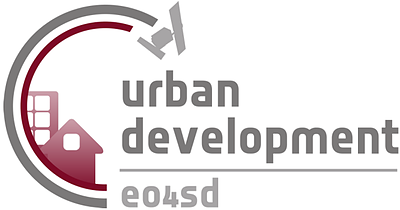Webinars
Below we provide the list of all past webinars given within the EO4SD-Urban project including a brief content description and the link to the related video recording.
1.1 - Geospatial Technology and its Applications for Urban Topics - An Overview
This webinar presents some of the major challenges in urban development and planning in developing countries and the potential for the application of geospatial data to improve assessment of urban growth and planning. These issues are illustrated with various satellite-based product examples from the EO4SD-Urban project portfolio.
No specific a-priori knowledge is required.
Date: 17/07/2018 + 12/09/2018
2.1 - Remote Sensing Introduction & Characteristics of Satellite Data
This webinar answers the questions: What is remote sensing? What is a satellite and how does it work? Which kind of sensor systems are available and what are their characteristics? No specific a-priori knowledge is required.
Date: 18/09/2018
2.2 - Basics of Image Classification & Geographical Information Systems
This webinar answers the questions: How can I generate information from satellite imagery? What is GIS? How can it be used?
Recommended a-priori knowledge: Webinar 2.1.
Date: 26/09/2018
2.3 - The Importance of Quality Control and Quality Assurance in Satellite EO Products
Geospatial data freely available on the internet are often used for decision-making without considering their limitations due to poor accuracy and quality control procedures. Additionally, geospatial data produced with no metadata and quality control (QC) pose problems related to transparency, repeatability of methods and consistency. In this webinar, the importance of proper accuracy assessment and quality assurance of EO products is discussed and emphasized.
No specific a-priori knowledge is required.
Date: 10/10/2018
2.4 - EO4SD-Urban – Overview of Available Products
This webinar provides a brief explanation of all currently generated products in the EO4SD-Urban portfolio. Users are given an overview of the products and their main properties without going much into technical details. Recommended a-priori knowledge: Webinars 2.1, 2.2, 2.3.
Date: 17/10/2018
3.1 - Satellites Help Developing Urban Master Plans
This webinar describes how Earth Observation products such as land use/land cover can be used as the basis for improved design and implementation of Master Plans. The assessment of urban growth and urban expansion are key aspects of the utility of Master Plans, as this information will help to define areas for new plans as well as improve existing plans.
Recommended a-priori knowledge: Webinars 2.1, 2.2, 2.3, 2.4.
Date: 17/10/2018
3.2 - Satellites Support Slum Upgrade and Access to Basic Services
Most urban centers in developing countries have very little current/accurate data available on the location, extent and the dynamics of informal settlements. Moreover, related information on level of service deprivation (e.g. water and sanitation access) are completely missing or they are limited to small local surveys. This webinar describes how satellite data can provide spatially disaggregated information with high spatial and temporal consistency, to address the gaps in information.
Recommended a-priori knowledge: Webinars 2.1, 2.2, 2.3, 2.4.
Date: 30/01/2019
3.3 - Satellites Help Improving Urban Livelihoods
Public urban spaces such as streets, open spaces, green areas, parks, and public buildings are necessary components for a livable city. Inadequate, poorly designed, or privatized public spaces often generate exclusion and marginalization and therefore degrade the livability of the urban environment. This webinar focuses on the role of EO data and GIS analysis which are used to improve the knowledge of these spaces and to give the authorities better tools for management and planning in order to reach Sustainable Development Goal 11.7.
Recommended a-priori knowledge: Webinars 2.1, 2.2, 2.3, 2.4.
Date: 06/02/2019
3.4 - Satellite Data for Assessment of Land Valuation and Property Taxes
The technical complexity of ensuring that tax rolls are complete and valuations current is often perceived as a major barrier to bringing in more property tax revenues in developing countries. This webinar shows how satellite data makes it possible to assess the completeness of existing tax maps by estimating built-up areas based on building heights and footprints. Together with information on sales prices from the land registry, targeted surveys, and routine statistical data, this makes it possible to use mass valuation procedures to generate tax maps. The example of Kigali in Rwanda illustrates the reliability of the method and the potentially far-reaching revenue impacts.
Recommended a-priori knowledge: Webinars 2.1, 2.2, 2.3, 2.4.
Date: 06/02/2019
3.5 - Satellite Data for Climate Resilience and Disaster Management City Plans
This webinar focuses on flood history and flood risk as well as on land motion (subsidence), but related topics that are touched upon are land use/land cover and change, transport infrastructure and green urban areas, as these are also relevant for assessing sustainability of cities with respect to climate resilience and disaster management. During the webinar use cases and applications of Earth Observation-based solutions are demonstrated for several cities.
Recommended a-priori knowledge: Webinars 2.1, 2.2, 2.3, 2.4.
Date: 27/02/2019
3.6 - Analysing Urban Areas Using Free Data and Open Online Tools
The aim of this webinar is twofold: first, to outline the use of the World Settlement Footprint (WSF) product for comparative analysis and, second, to present a set of online tools which can be used to generate statistics and geo-spatial analysis hosted on ESA’s Urban Thematic Exploitation Platform (U-TEP).
Recommended a-priori knowledge: Webinars 2.1, 2.2, 2.3, 2.4.
Date: 06/03/2019

